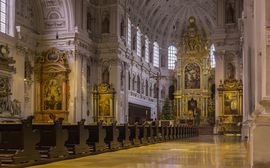THE JESUIT CHURCH OF ST. MICHAEL

The History of the Jesuit Church of St. Michael
In 1556, Duke Albrecht V of Bavaria made an agreement with the Jesuit order, founded in 1540, to establish a secondary school in Munich. It was his son, William V, who then had the church and college of St. Michael built in Neuhauser Straße from 1583–1597. The school and church were run by the Jesuits until 1773, when St. Michael’s became the court church.
The Jesuit order has been back at St. Michael’s since 1921. The church was severely damaged by bombing during the 2nd World War and was rebuilt and renovated in 1944.
St. Michael also served as the spiritual centre of the Counter-Reformation in Bavaria and, as it did during the great social upheaval over 400 years ago, it continues to shape the lives of people in the city in the spirit of Jesus Christ to this day. Through sermons, retreats, lectures, daily confession and conversations, the Jesuits offer an understanding ear and guidance in a ministry mainly directed at the unchurched.
Design and Background of the Jesuit Church of St. Michael in Munich
The interior of the Jesuit Church of St. Michael in Munich is covered by the largest cantilevered barrel vault north of the Alps and the second largest in the world. Inside the main entrance is a depiction of Jesus as a child. The story of Jesus’ life continues around the long nave, accompanied by angels, holding the instruments of his suffering in their hands.
The choir over the crypt depicts the resurrection, with the kingdom of heaven with Jesus reigning in glory at the pinnacle of the high altar beyond. This stands as a beacon of hope to the faithful that Christ will come back at the end of the time and bless all people in the city.
St. Michael also houses a royal crypt, as it was intended from the start to be the final resting place for the House of Wittelsbach. St. Michael, therefore, is one of the most important resting places of the Bavarian rulers in addition to Theatinerkirche and the Frauendom. William V and his son, Elector Maximilian I, both requested to be buried in the crypt of St. Michael. King Ludwig II, most likely Bavaria’s most famous ruler, was buried in St. Michael, just like his brother King Otto.
The Façade
Duke Wilhelm V, for whom education was as important to Wilhelm V as were the city hall and the market, wanted the façade of the college, church and the square on which they stand to be an architectural highlight of his capital city.
Statues of fifteen rulers who had cared for the welfare of the city’s citizen form the procession behind the Archangel Michael, the patron of the church and the college. Michael is said to keep wickedness in check on God’s behalf and promote the goodness in humankind. Guarding the entrance of the church is a bronze statue of Michael triumphing over Satan (H. Gerhard, 1588).
The Jesuit Church of St. Michael on Neuhauser Straße in Munich has been undergoing restoration since 2009. Among other things, the exterior has been repainted and the statues are once again in a brilliant white. In April, the scaffolding will be permanently removed and the restoration work completed. The major restoration project began after plaster and stone broke off the façade and fell onto the street below in 2007. The new façade will be dedicated with a solemn Mass on 5 May 2013.
You can reach the Jesuit Church of St. Michael from the Platzl Hotel Munich in about 10 minutes by foot. The church is open:
Monday and Friday 10 am – 7 pm,
Tuesday, Wednesday, Thursday and Saturday from 8 am – 7 pm,
and Sunday from 7 am – 10:15 pm. In addition to Masses held every Sunday, the church also organizes a monthly St. Michael Concerts. The church is well worth a visit and admission is free. For more information on dates and content, visit the official website.
